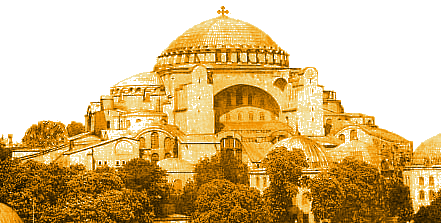Nadia Maria El-Cheikh
From : “Byzantium through the Islamic Prism
from the Twelfth to the Thirteenth Century”, included in
The Crusades
from the Perspective of Byzantium and the Muslim World, ed. Angeliki
E. Laiou and Roy Parviz Mottahedeh, Dumbarton Oaks © 2001 -
Here published with title and subtitles by
Elpenor.
Historiography
|||
The twelfth and
thirteenth centuries |||
al-Rum |||
Byzantine
skills |||
General
character |||
Constantinople
|||
Constantinople
and Jerusalem |||
1204 |||
Symbols of
Constantinople |||
Islamic
monuments of Constantinople
Page 12
The
twelfth-and thirteenth-century Arabic-Islamic sources include a few
major sites that repeatedly appear in Muslim sources. Although the
authors copied one another, it is these sites, whether or not actually
visited by our authors, that seem to have served as prototype symbols
of Constantinople. The list includes the Golden Gate, the Column of
Justinian, the Column of Theodosius, the Horologium, the Bronze
Horses, and Hagia Sophia.
According to
al-Harawi, “the great church is Haghia Sophia.“ Al-Qazwini gives the
following description:
The king’s
church has a golden dome and ten gates: six of gold and four of
silver. The place where the king stands is 4 by 4 arms’ lengths and is
ornamented with pearls and rubies. ... All the walls of the church are
covered with gold and silver. There are twelve columns, each four
arms’ length, and on top of each is a statue of a human, a king, a
horse, a lion, a peacock, an elephant, or a camel. Next to it is a
container which, when filled, brings the water up to the statues. On
Palm Sunday ... they fill the divisions of the container with oil,
wine, honey, rose water, and vinegar, which are all scented. ... As
the container is covered, the liquids flow out from the mouths of the
statues.
 Similarly,
al-Dimashqi describes “the Great Church, where it is said that an
angel resides and where lies a colossal high altar with huge doors and
columns.“ Al-Jazari also includes a description of Hagia Sophia
provided by the merchant ‘Abdallah: “The church is one of the most
considerable and marvelous buildings that we can see. The place in
which they stand for praying is surrounded by grills. ... On the walls
of this church are represented all the cities of the world and all the
crafts. When one of them wants to choose a craft for his son, he takes
him to the walls and shows him the crafts.“ Similarly,
al-Dimashqi describes “the Great Church, where it is said that an
angel resides and where lies a colossal high altar with huge doors and
columns.“ Al-Jazari also includes a description of Hagia Sophia
provided by the merchant ‘Abdallah: “The church is one of the most
considerable and marvelous buildings that we can see. The place in
which they stand for praying is surrounded by grills. ... On the walls
of this church are represented all the cities of the world and all the
crafts. When one of them wants to choose a craft for his son, he takes
him to the walls and shows him the crafts.“
Cf.
Christianity and Islam -
Two related, yet different religions *
Koran – the invention of
an artificial religion * Turkey
* The Orthodox
Church * Byzantine history * On the Byzantine Military Strategy *
Greek Language
On Line Resources for Constantinople
Greek Forum : Make a question / Start a
Discussion
|